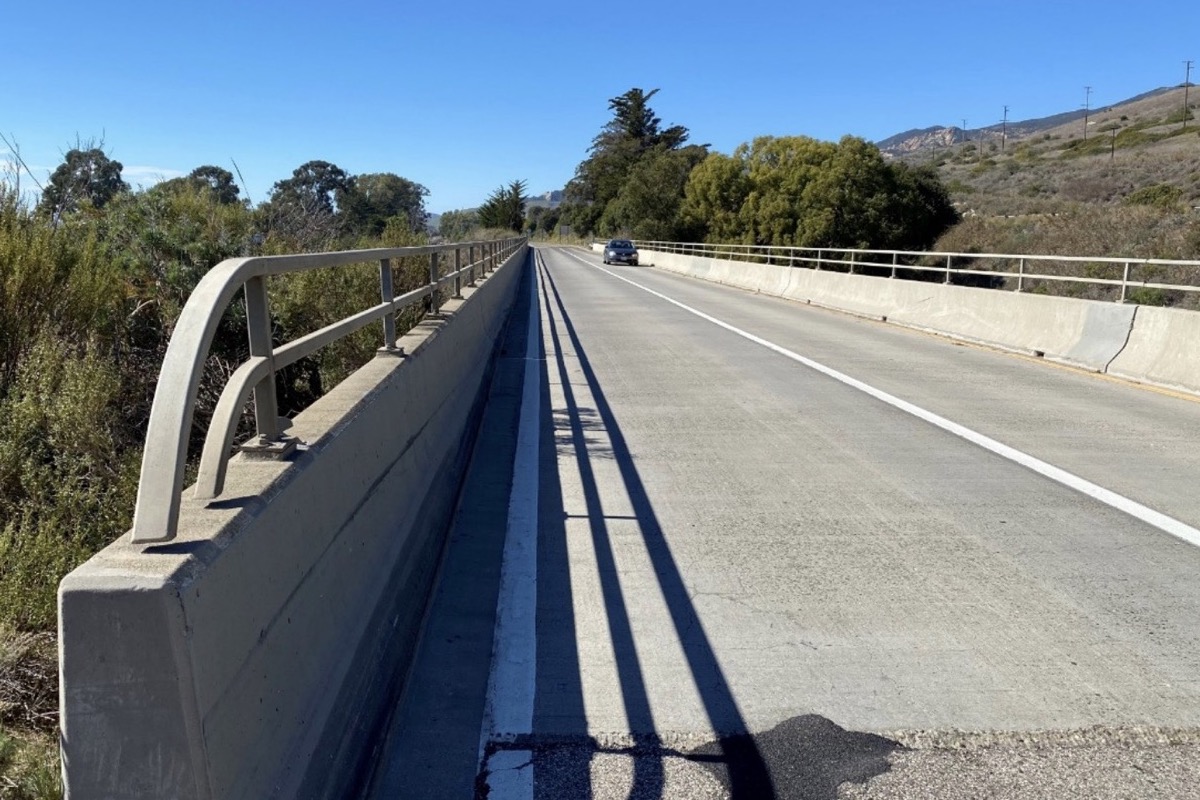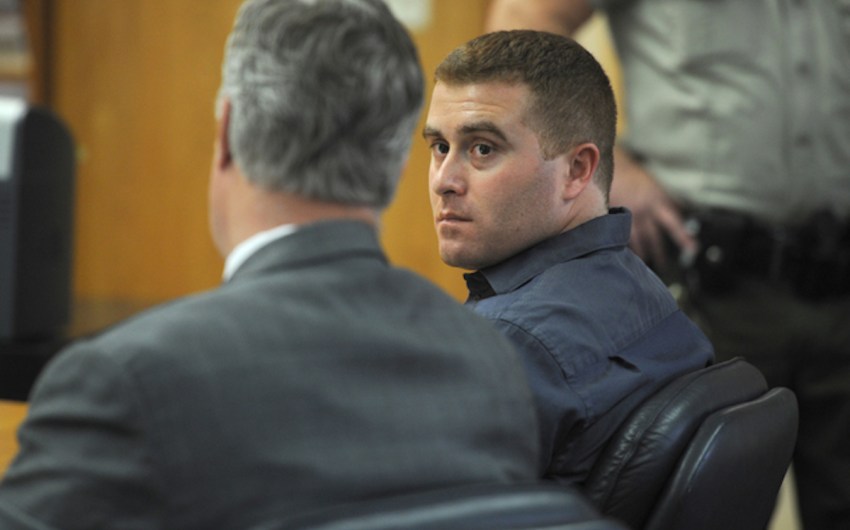Injured Santa Barbara Cyclist Awarded $3.8 Million in Negligence Case Against Caltrans, Driver
Jury Finds Highway 101’s Arroyo Quemada Bridge Is ‘Dangerous’ Piece of Public Property

Ronald Wilmot wasn’t exactly “scared” of the Arroyo Quemada Bridge. “But very aware,” he said. “That’s the word.”
Whenever the retired elementary school principal and his friends would cross the narrow stretch of Highway 101 on their regular bike rides between Santa Barbara and Gaviota, he said, “we would look in our mirrors to make sure an 18-wheeler wasn’t coming, wave our left arms, and ride like hell.”
On January 3, 2021, Wilmot ― the last in a line of four cyclists ― was hit from behind by a motorist who said she felt squeezed by another car and veered into their bike lane, which merges into the slow lane of traffic on the bridge and shrinks to a 12-inch shoulder. The driver said she never even saw the group.
Wilmot, 84 years old at the time, suffered a serious compound break of his left leg above the ankle, seven busted ribs, a punctured lung, and compression fracture to his spine. “But no head injuries,” he said, thanking his helmet. He spent weeks in the hospital, and though he can walk again with hardware in his leg, Wilmot has given up riding, a major part of his life since he was 19.
On March 20, a Santa Barbara jury unanimously awarded Wilmot $3.8 million in a negligence lawsuit against Caltrans, owner and operator of Arroyo Quemada Bridge, and the driver, a 68-year-old Buellton resident. How the payment is divided between the two parties will be decided at a later hearing.
Most significantly, the jury found that the 400-foot bridge ― part of the state’s official Pacific Coast Bike Route ― constituted “a dangerous condition of public property,” and that Caltrans had failed to properly warn motorists of this “concealed trap.” While Caltrans has installed a “clutter” of signage around the bridge, the jury also said, none of it notifies drivers that bicyclists may occupy the slow lane.
During the two-week trial, Wilmot’s attorneys introduced evidence that the state transportation agency knew the bridge was dangerous as far back as 1999, when representatives of its District 5 office in San Luis Obispo met with Santa Barbara County officials to discuss possible safety improvements. Another sit-down took place in 2011, but Caltrans never followed through on its plan for a new cantilevered bike lane along the bridge that would separate cyclists from motorists.
A key witness for Wilmot’s legal team was Wilson Hubbell, a former county transportation planner who attended that 1999 meeting. Hubbell testified Caltrans was well aware of the issues at the time and promised to address them with the new lane but, for reasons unclear, never started construction.
“The potential for problems out there are so apparent,” Hubbell said in an interview. “The bridge was built in 1917 for 1917 vehicles,” he noted. “They were slower, and there were fewer of them.” Now, approximately 16,000 cars traveling between 55 and 70 mph cross it each day. “What amazes me is that it took this long for an accident like this to happen,” he said.
Hubbell said he and his colleagues felt “shined on” by Caltrans during their meeting, and he lamented he retired before any changes to the bridge could be made. But he was glad to testify on Wilmot’s behalf. “These guys knew this was a problem 25 years ago,” he said. “And they did nothing.”
Hubbell, also a cyclist who’s made the trip up to Gaviota, agreed the crossing is “spooky, to say the least. It’s about the longest 20 seconds of your life.”
Through a spokesperson, Caltrans ― which denied throughout the trial that Arroyo Quemada Bridge constituted a “dangerous condition” ― declined to address the case. “Caltrans has no comment on this matter at this time,” said Public Information Officer Genelle Padilla.
As a legal matter, the verdict doesn’t compel Caltrans to make any safety improvements to the bridge, explained Wilmot attorney Lawrence Marks. “But I hope they do,” he said. “Something needs to happen,” said co-counsel Bradford Brown. “This was less about collecting for Ron than getting Caltrans to act.”
Wilmot, now 87, said the money is nice, but he’s also more concerned that no one else gets hurt. “The big thing is something is finally going to get done about that bridge,” he said. “Maybe not in my lifetime, but soon.”
Wilmot said he misses cycling but still gets his exercise on a spin bike set up in the garage. He also gardens and cares for his wife. Wilmot had hoped to remain on the road into his nineties to set an example for his friends and adult children to stay active. “Now,” he said, “I’ll just have to model it in different ways.”
“While I did get hurt, and it certainly did change my life, I’m the type of person who can roll with that,” Wilmot continued. “You can’t hold grudges, and you can’t look over your shoulder. I feel good about the whole thing.”
Premier Events
Sun, Dec 22
11:00 AM
Santa Barbara
Mosaic Makers Market – Holiday Market Finale
Wed, Dec 25
6:00 PM
Santa Barbara
FREE Contra Dance X-mas Day💃Corwin & Grace band6-9
Sun, Dec 22
11:00 AM
Santa Barbara
Mosaic Makers Market – Holiday Market Finale
Sun, Dec 22
2:00 PM
Santa Barbara
Santa Paws Holiday Party – A Howliday Celebration
Tue, Dec 24
2:00 PM
Santa Barbara
Brass Bear Christmas Eve Buffet
Tue, Dec 24
5:00 PM
Santa Barbara
Christmas Eve at the USSB
Wed, Dec 25
5:30 PM
Santa Barbara
Christmas Dinner at El Encanto
Fri, Dec 27
6:00 PM
Solvang
New Year Disco Ball Paint & Sip
Fri, Dec 27
9:00 PM
Santa Barbara
Film Screening: “Indiana Jones and The Last Crusade”
Sat, Dec 28
7:00 PM
Lompoc
Rosie Flores & Grey DeLisle + Special Guests LIVE
Sat, Dec 28
7:00 PM
Carpinteria
Family Comedy Night at The Alcazar
Sat, Dec 28
7:00 PM
Santa Barbara
The Temptations at Casa De La Raza
Sun, Dec 22 11:00 AM
Santa Barbara
Mosaic Makers Market – Holiday Market Finale
Wed, Dec 25 6:00 PM
Santa Barbara
FREE Contra Dance X-mas Day💃Corwin & Grace band6-9
Sun, Dec 22 11:00 AM
Santa Barbara
Mosaic Makers Market – Holiday Market Finale
Sun, Dec 22 2:00 PM
Santa Barbara
Santa Paws Holiday Party – A Howliday Celebration
Tue, Dec 24 2:00 PM
Santa Barbara
Brass Bear Christmas Eve Buffet
Tue, Dec 24 5:00 PM
Santa Barbara
Christmas Eve at the USSB
Wed, Dec 25 5:30 PM
Santa Barbara
Christmas Dinner at El Encanto
Fri, Dec 27 6:00 PM
Solvang
New Year Disco Ball Paint & Sip
Fri, Dec 27 9:00 PM
Santa Barbara
Film Screening: “Indiana Jones and The Last Crusade”
Sat, Dec 28 7:00 PM
Lompoc
Rosie Flores & Grey DeLisle + Special Guests LIVE
Sat, Dec 28 7:00 PM
Carpinteria
Family Comedy Night at The Alcazar
Sat, Dec 28 7:00 PM
Santa Barbara
























